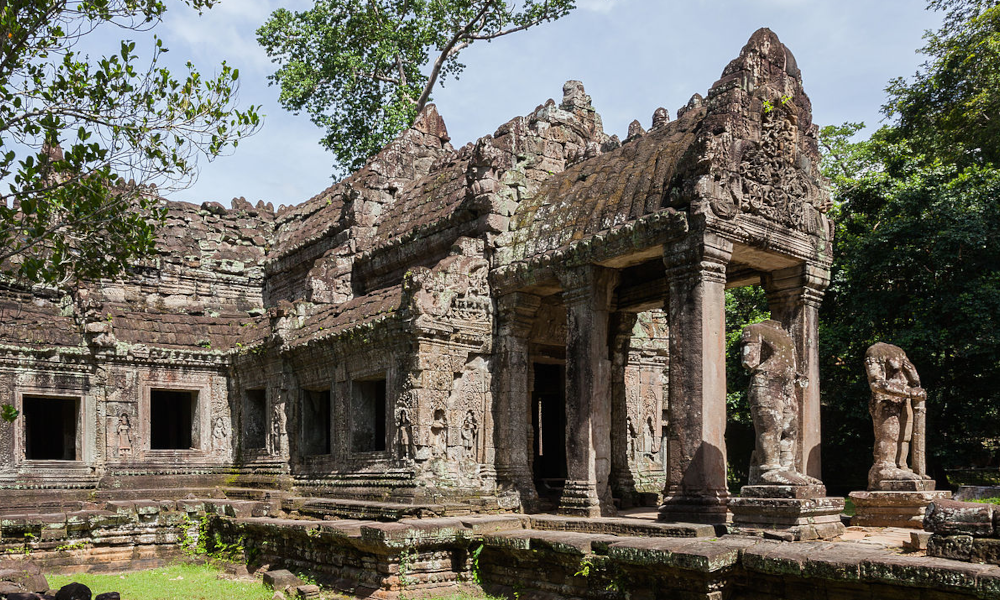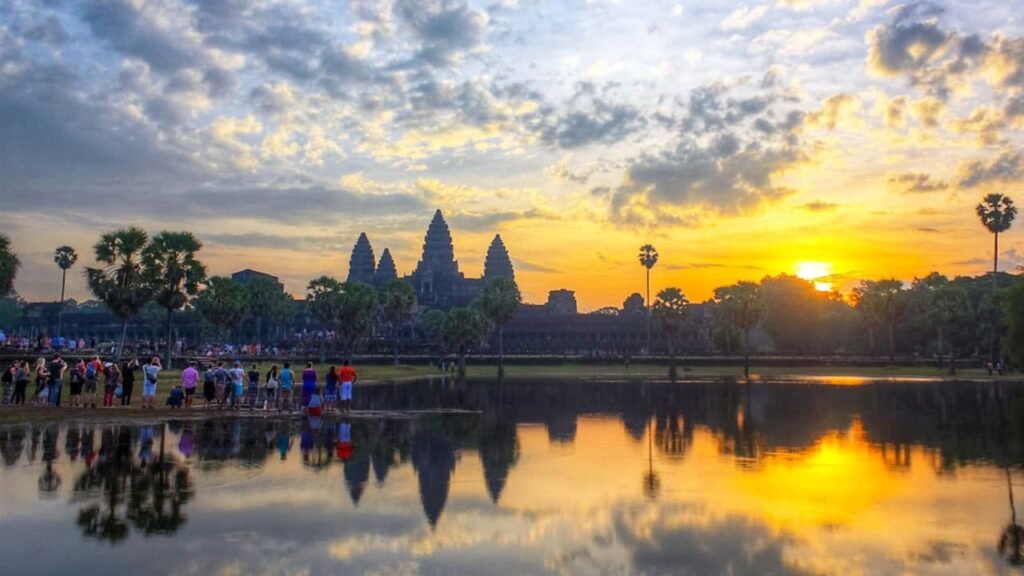Preah Khan Temple

Preah Khan temple is situated within the Angkor Archaeological Park and remains predominantly unrestored. It ranks among the larger temple complexes in this historic site. The name Preah Khan translates to “Holy Sword” in Khmer, a designation given by Jayavarman VII to commemorate his military triumph over the invading Chams, who hailed from a kingdom in present-day Vietnam, in the year 1191.
This impressive temple complex is encircled by a moat, covering a land area of 800 meters by 700 meters, which amounts to 56 hectares. Its architectural style bears a striking resemblance to the renowned Angkor temple Ta Prohm, where nature appears to reclaim the ruins through the growth of vegetation and trees.
Explore Siem Reap’s iconic temples on this immersive 2-day tour. With a local, English-speaking guide, discover the grandeur of Angkor Wat, the ancient ruins of...
Architecture of Preah Khan Temple
The architecture of Preah Khan is elaborately adorned, particularly the outer wall, which features five-meter-tall Garudas engaged in combat with Naga snakes. This outer wall is encircled by a moat.
Access to the temple complex is provided through four gates, each connected by a causeway that spans the moat. The principal entrance is located on the eastern side, where remnants of a small landing stage for boats can be found, flanked by two guardian lions. This pier is situated on the western bank of the Jayatataka Baray, from which the King would embark by boat to the Neak Pean temple at the reservoir’s center.
On the northern side of the complex lies a House of Fire, constructed in a style akin to similar structures at Ta Prohm and Banteay Chhmar. Scholars suggest that these houses likely served as rest areas with fireplaces for travelers.
The complex is divided into four enclosures. Historically, wooden dwellings for servants and villagers were located along the perimeter of the fourth enclosure or outer wall.
In a manner reminiscent of Ta Prohm and Banteay Kdei, Preah Khan features a magnificent Hall of Dancers, situated within the third enclosure just beyond the Gopura of the eastern entrance. Above the entrance doors, one can admire exquisitely carved Devatas.
The second enclosure is characterized by a narrow passageway separating it from the first and contains six sanctuary buildings on its eastern side.
The first enclosure, known as the inner sanctuary, represents the most sacred area of the temple. The walls are adorned with images of Buddha, and the limited space is lined with small chapels and tombs.
Location and How to Get There
Preah Khan is situated within the Grand Circuit of the Angkor Archaeological Park, which encompasses a 26-kilometer loop that extends from the smaller circuit. To reach this temple and explore the remainder of the circuit, it is recommended to hire a tuk-tuk driver. While the smaller circuit can be navigated by bicycle with relative ease, completing the larger circuit in a single day by bicycle may prove to be more difficult.
Preah Khan is positioned to the north of Angkor Thom. To the east of Preah Khan is the Jayatataka Baray, an artificial water body that beautifully reflects the nearby temples and surrounding jungle. At the center of this reservoir lies an island featuring the Neak Pean temple. Once dry, the Jayatataka Baray has been replenished with water, and at the conclusion of each rainy season, any excess water is redirected back into it.
It is important to distinguish Preah Khan of Angkor Archaeological Park from the similarly named temple located in Kampong Svay, which is situated 100 kilometers to the east of Angkor.
History of Preah Khan
The Preah Khan temple complex was constructed in the 12th century under the reign of King Jayavarman VII, intended as a tribute to his father, King Dharanindravarman II. This site once functioned as a significant religious and urban center, encompassing a temple and a Buddhist university.
A notable feature of Preah Khan is the Preah Khan stele, a stone carving measuring 2 meters by 0.6 meters, inscribed on all four sides. Discovered in 1939 by Maurice Glaize, a French conservator of Angkor, this stele provides extensive historical insights about Preah Khan. It includes invocations to Lokeshvara and Prajnaparamita, as well as reverence for the three jewels of Buddhism: the Buddha, the Dhamma (Buddhist teachings), and the Sangha (the Buddhist community). The stele also extols King Jayavarman VII and mentions the name of the city within the complex, Nagara Jayasri (the Holy City of Victory). Furthermore, it records the population of the temple city as 100,000, comprising rice farmers, monks, and dancers, along with an inventory of the kingdom’s treasury, which included silver, gems, and gold.
Since 1991, Preah Khan has been the focus of a restoration and maintenance initiative, overseen by the World Monuments Fund. This project marked the first significant effort of its kind following the conclusion of Cambodia’s tragic civil war, which occurred from 1967 to 1975.

